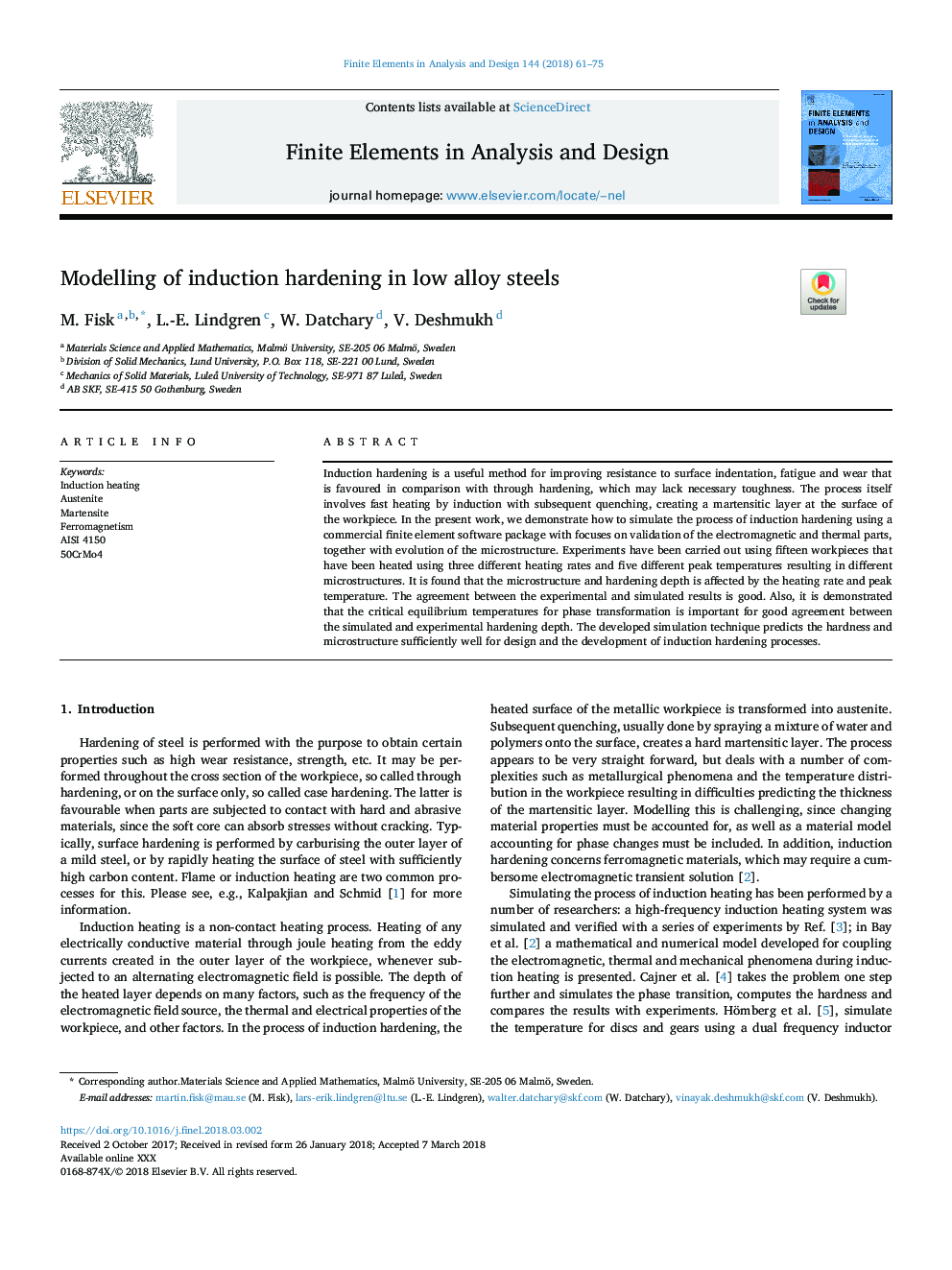| کد مقاله | کد نشریه | سال انتشار | مقاله انگلیسی | نسخه تمام متن |
|---|---|---|---|---|
| 6925357 | 1448755 | 2018 | 15 صفحه PDF | دانلود رایگان |
عنوان انگلیسی مقاله ISI
Modelling of induction hardening in low alloy steels
ترجمه فارسی عنوان
مدلسازی سختی القایی در فولادهای کم آلیاژ
دانلود مقاله + سفارش ترجمه
دانلود مقاله ISI انگلیسی
رایگان برای ایرانیان
کلمات کلیدی
ترجمه چکیده
سخت شدن القایی یک روش مفید برای بهبود مقاومت به اندام سطحی، خستگی و سایش است که در مقایسه با سخت شدن، که ممکن است سختی لازم را نداشته باشد، مورد توجه قرار گیرد. فرایند خود را به وسیله القاء بوجود می آورد و سپس با خنک کردن آن، ایجاد لایه مارنزیتی در سطح قطعه کار می کند. در این مقاله، ما نشان می دهیم که چگونه با استفاده از یک بسته نرم افزاری نرم افزار محدود با تمرکز بر اعتبار سنجی قطعات الکترومغناطیسی و حرارتی، همراه با تکامل ریزساختار، شبیه سازی روند سخت شدن القایی را نشان می دهد. آزمایش ها با استفاده از پانزده قطعه کار انجام شده است که با استفاده از سه نرخ گرمای مختلف و پنج درجه پیک متفاوت که منجر به ایجاد ریز ساختار های مختلف می شوند، حرارت داده شده است. مشخص شده است که ریزساختار و عمق سخت شدن توسط درجه گرمایش و دمای پیک تحت تاثیر قرار می گیرد. توافق بین نتایج تجربی و شبیه سازی شده خوب است. همچنین نشان داده شده است که دمای تعادلی بحرانی برای انتقال فاز برای توافق خوب بین عمق سخت افزاری شبیه سازی شده و تجربی مهم است. تکنیک شبیه سازی پیشرفته، سختی و ریز ساختار را به خوبی برای طراحی و توسعه فرایندهای سخت شدن القایی پیش بینی می کند.
موضوعات مرتبط
مهندسی و علوم پایه
مهندسی کامپیوتر
نرم افزارهای علوم کامپیوتر
چکیده انگلیسی
Induction hardening is a useful method for improving resistance to surface indentation, fatigue and wear that is favoured in comparison with through hardening, which may lack necessary toughness. The process itself involves fast heating by induction with subsequent quenching, creating a martensitic layer at the surface of the workpiece. In the present work, we demonstrate how to simulate the process of induction hardening using a commercial finite element software package with focuses on validation of the electromagnetic and thermal parts, together with evolution of the microstructure. Experiments have been carried out using fifteen workpieces that have been heated using three different heating rates and five different peak temperatures resulting in different microstructures. It is found that the microstructure and hardening depth is affected by the heating rate and peak temperature. The agreement between the experimental and simulated results is good. Also, it is demonstrated that the critical equilibrium temperatures for phase transformation is important for good agreement between the simulated and experimental hardening depth. The developed simulation technique predicts the hardness and microstructure sufficiently well for design and the development of induction hardening processes.
ناشر
Database: Elsevier - ScienceDirect (ساینس دایرکت)
Journal: Finite Elements in Analysis and Design - Volume 144, May 2018, Pages 61-75
Journal: Finite Elements in Analysis and Design - Volume 144, May 2018, Pages 61-75
نویسندگان
M. Fisk, L.-E. Lindgren, W. Datchary, V. Deshmukh,
